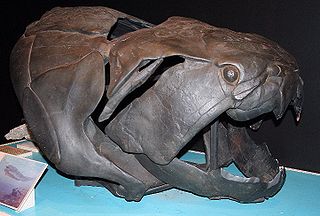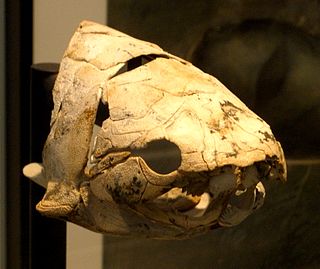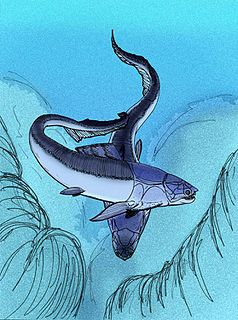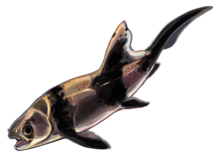
Dunkleosteus is an extinct genus of large armored, jawed fishes that existed during the Late Devonian period, about 382–358 million years ago. It consists of ten species, some of which are among the largest placoderms to have ever lived: D. terrelli, D. belgicus, D. denisoni, D. marsaisi, D. magnificus, D. missouriensis, D. newberryi, D. amblyodoratus, and D. raveri. The largest and most well known species is D. terrelli, which grew up to 8.79 m (28.8 ft) long and 4 t in weight. Dunkleosteus could quickly open and close its jaw, like modern-day suction feeders, and had a bite force of 6,000 N at the tip and 7,400 N at the blade edge. Numerous fossils of the various species have been found in North America, Poland, Belgium, and Morocco.

Coccosteus is an extinct genus of arthrodire placoderm from the Devonian period. Its fossils have been found throughout Europe and North America. The majority of these have been found in freshwater sediments, though such a large range suggests that they may have been able to enter saltwater. The largest specimens were about 40 centimetres (16 in), although the average length was 20 to 24 centimetres.

Dinichthys is an extinct monospecific genus of giant, marine arthrodire placoderm from the Late Devonian, comparable in size, shape, and ecological role to the better-known Dunkleosteus. Fossils were recovered from the Ohio Shale Formation along the Olentangy River in Delaware County, Ohio.

Coccosteina is an extinct infraorder of placoderms, armored fish most diverse during the Devonian. However, the term is no longer in use, as modern cladistical methods have produced alternative phylogenetic trees of Brachythoraci with new subdivisions.

Dunkleosteidae is an extinct family of arthrodire placoderms that lived during the Devonian period. The gigantic apex predator Dunkleosteus terrelli is the best known member of this group.

Eastmanosteus is a fossil genus of dunkleosteid placoderms. It was closely related to the giant Dunkleosteus, but differed from that genus in size, in possessing a distinctive tuberculated bone ornament, a differently shaped nuchal plate and a more zig-zagging course of the sutures of the skull roof.

Plourdosteus is an extinct genus of placoderm arthrodire which was relatively widespread in Euramerica during the Givetian to Frasnian ages of the Devonian.

Mcnamaraspis is an extinct monospecific genus of arthrodire placoderm that inhabited the ancient reef system of north Western Australia during the Frasnian epoch of the Late Devonian period. The type specimen was found and described by John A. Long from the Gogo Formation near Fitzroy Crossing. This fossil fish showed new anatomical features in arthrodires, like the well-preserved annular (ring-shaped) cartilages of the snout, previously inferred to be present by Erik Stensiö of Sweden. It is occasionally referred to as "The Gogo Fish" after the locale the holotype was excavated from.

Xiangshuiosteus wui is an extinct monospecific genus of brachythoracid arthrodire placoderm from the Late Emsian stage of the Early Devonian epoch, discovered in Wuding County of Yunnan province, China. It has recently been reassessed as a dunkleosteid.

Protitanichthys is an extinct genus of comparatively large coccosteid arthrodire placoderms from the Middle Devonian of the eastern United States. Fossils are found primarily in the Eifelian-epoch aged Delaware Limestone of Ohio, and the Lower Givetian-aged Rockport Quarry Limestone of Michigan

Homostiidae is a family of flattened arthrodire placoderms from the Early to Middle Devonian. Fossils appear in various strata in Europe, Russia, Morocco, Australia, Canada and Greenland.

Buchanosteidae is a family of arthrodire placoderms that lived from the Early to Middle Devonian. Fossils appear in various strata in Russia, Central Asia, Australia, and China.

Pteraspidiformes is an extinct order of heterostracan agnathan vertebrates known from extensive fossil remains primarily from Early Devonian strata of Europe and North America, and from Upper Silurian Canada.

Kiangyousteus is an extinct monotypic genus of dunkleosteid from the Middle Devonian: Givetian aged Guanwu Formation in the Sichuan province of south-western China. The type species, Kiangyousteus yohii, was the first known arthrodire from Asia.

Panxiosteidae is an extinct family of arthrodire placoderms that lived during the Devonian period.
Panxiosteus is an extinct monospecific genus of placoderm arthrodire from the Middle Devonian: Givetian stage of Yunnan province, China.
Janiosteus is an extinct monospecific genus of placoderm arthrodire from the Middle Devonian: Late Givetian stage found in Timan, Russia.

Millerosteus is an extinct genus of coccosteid arthrodire placoderm from the Early Givetian stage of the Middle Devonian period. Fossils are found in the Orkneys and Caithness, Scotland.
Dickosteus is an extinct genus of coccosteid arthrodire placoderm from the Late Eifelian to Early Givetian stages of the Middle Devonian period. Fossils are found in the Orkneys and Caithness, Scotland.
Watsonosteus is an extinct genus of coccosteid arthrodire placoderm from the Late Givetian stage of the Middle Devonian period. Fossils are found in the Orkney Islands, Scotland.






















